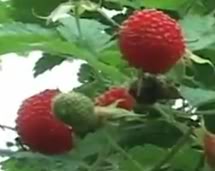Sapinit is a shrub that has prickly stem, thereby identifying it with the rose family and making it a raspberry rather than a strawberry. It reaches to a height of six feet and grows in a higher elevation of 1,000 to 2,000 feet above sea level that can be mostly found in Mt. Banahaw in Quezon and in Laguna. Its fruit has bright red-orange color that accounts for its phytochemical richness. It has sweet-sour-bitter taste that makes for its uniqueness. Sapinit was initially discovered by a Filipino OFW in Australia, Dionisio Pullan.
 Sapinit or the Philippine wild raspberry has many health benefits. According to a phytochemical analysis of Sapinit done by the Industrial Technology Development Institute and the University of the Philippines Los Banos-Biotech funded by BAR program, sapinit is rich in anti-cancer phytochemicals including leucoanthocyanins, anthraquinones, saponins, deoxysugars, free fatty acids, hydrolysable tannins (inhibitors of HIV duplication), unsaturated steroids, and benzopyrone nucleus.
Sapinit or the Philippine wild raspberry has many health benefits. According to a phytochemical analysis of Sapinit done by the Industrial Technology Development Institute and the University of the Philippines Los Banos-Biotech funded by BAR program, sapinit is rich in anti-cancer phytochemicals including leucoanthocyanins, anthraquinones, saponins, deoxysugars, free fatty acids, hydrolysable tannins (inhibitors of HIV duplication), unsaturated steroids, and benzopyrone nucleus.
An important function of anthraquinones is it inhibits formation of Tau aggregates and dissolve paired helical filaments thought to be critical to the development of Alzheimer’s disease.
With anthraquinones, Sapinit also gets an industrial use potential. Anthraquinones is a precursor to synthetic dyes, an additive in paper pulp making, and is a material for hydrogen peroxide.
Leucoanthocyanin is a flavonoid found in many plants including berries which are potential modifiers of carcinogens. Moreover, some saponins have been shown to very significantly augment the cytotoxicity of immunotoxins and other targeted toxins directed against human cancer cells.
Sapinit is considered a plant useful for environmental sustainability as it does not need continuous cultivation, and it can live for many years. This way, it retains soil fertility. Sapinit is propagated both through suckers and cuttings.
The Philippine wild raspberry “Sapinit” can be processed into juice, jam, and wine. Sapinit is also processed into vinaigrette for salad dressing, tea from its leaves and as food flavoring. One kilo of raw Sapinit may be turned into four bottles of jam or four bottles of juice. The same one kilo may also be processed into five 350 ml wine. Sapinit has a bright potential as a specialty product as its price in the market is high. However, shelf life of fresh fruits is only three-four days.
“Sapinit has a very important role in uplifting the livelihood of communities because without it, they just depend on cash crops,” said Dennis Bihis, QAES researcher.
Sapinit: Philippine Wild Raspberry
Source: afmis.da.gov.ph

where can I buy sampinit fruit? I need it for research purposes.
hello! can i ask what is your research all about po? thank you so much.
Will those varieties grow also in the lowlands?
yes, I have one and i am from Valenzuela city.
It is easy to cultivate sapinit plant in 300 m altitude in partial shades.I have the Sierra Madre variety which is more aromatic and strawberry like flavor and sweetness.I am planning to purchase the Banahaw variety this month.
hi, i would like to ask for the contact number of contact person for the sapinit production in department of agriculture. Please email it on dulceneananz@yahoo.com. Thank you so much!